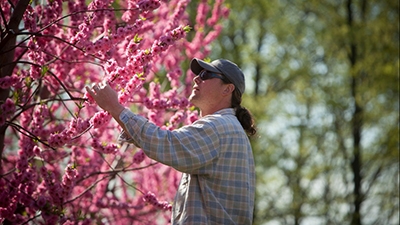Feb 6, 2018New tool forecasts spring’s arrival months in advance
Punxsutawney Phil – the prognosticating groundhog who famously foretells the arrival of spring – may need a new job. Cornell’s Emergent Climate Risk Lab has unveiled Springcasting, a web tool to determine the onset of spring – a season before it occurs.
“We’re trying to look beyond the typical five- to 10-day barrier of traditional meteorological forecasts by focusing on the timing of spring indicators, not just warm or cold temperatures,” said Toby Ault, assistant professor of earth and atmospheric sciences.
“Our Springcasting product tries to predict spring onset a season in advance. The climate is changing, and the onset of spring impacts agriculture, orchards, insects, migrating birds, pollinators, quite literally an entire suite of ecosystem responses. We’re trying to get a heads-up a season ahead of what to expect each year,” he said.
The new tool’s map of the continental U.S. shows in color where spring will be early, late or right on time. Updated forecasts will be issued Jan. 31, Feb. 15, Feb. 28, March 15 and March 31 for this spring.
In 2017, spring arrived early throughout most of the Southeast, Southwest and the Midwest. “Spring was crazy last year, more than 20 days early in several places. That took everyone by surprise,” Ault said, explaining that he and his colleagues examined models and circumstances from late 2016 forward. “Could we have seen that coming? The answer was pretty much ‘yes.’ We probably could have predicted the crazy early spring last year, if we had tried.”
This year, Ault and his colleagues aim to predict spring onset for all regions in the U.S. months in advance. Current forecasts predict much of the West, Southwest and parts of the Southeast will have an early spring. Growers and natural resource managers, for example, could use the spring outlooks to make critical decisions about allocating assets on long lead-time horizons.
Ault has collaborated with Mark D. Schwartz, professor of geography/climatology at the University of Wisconsin-Milwaukee; Julio Betancourt of the U.S. Geological Survey; and the USA National Phenology Network (USA-NPN) to develop and apply quantitative indices of spring onset for North America.
Three decades ago, Schwartz developed a method for predicting when lilac and honeysuckle leaves would emerge, which are phenological (the relationship between seasonal and biological) events based on meteorological data. He expanded the phenology models to the continent.
“The continental models are only as accurate as the long-lead temperature data that goes into them,” said Schwartz. “The Springcaster tool not only makes the information more precise, but it puts the data into a form that’s easier for users to interpret.”
Two years ago, USA-NPN issued index maps to track the start of spring across the continental U.S. Using the National Oceanic and Atmospheric Administration’s Climate Forecast System. Carlos Carrillo, a postdoctoral researcher in Ault’s laboratory group, applied additional parameters to the data by using a novel statistical approach that improved early spring predictability.
Scientists found two challenges with the Springcasting tool: communicating uncertainties and issuing forecast updates. Ault is collecting feedback on the site at [email protected]. “To improve the models, we want to hear from people out in the field and on the farms,” he said.
–Blaine Friedlander, Cornell University
Photo above: Eric Shatt, farm manager at Cornell Orchards, inspects the flowering buds on apple trees in late April.















